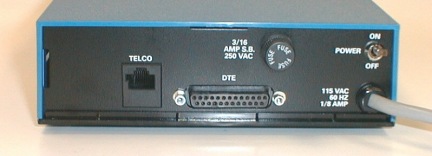
Leased-Line
Modems
or Lease Line Modem
LL Modem
A Leased Line modem is a high-speed modem designed for use in a private communications channel leased from a common carrier. Most digital lines require four wires (two pairs) for full-duplex transmission. It may have built-in lower speeds for alternate use in dial-up lines.
A leased line is a fixed, dedicated, digital,
point to point line for data transfer. The term "leased line" is a general
description of a point to point circuit from a data carrier supplier. These
circuits can be supplied at various speeds and be presented at your site with
various interfaces. A leased line is not connected to a telephone exchange and
does not provide DC power, dial tone, busy tone or ring signal.
Transmission speeds of leased lines vary from 64kbps up to several megabytes,
but the costs increase dramatically beyond 128kbps. For most small companies or
home users, ISDN is quite suitable, as it is capable of speeds of up to 128kbps.
Unlike ISDN, there is no usage charge for a leased line, only fixed annual
costs, which is at a higher rate than ISDN. Due to usage charges, it is
generally recommended that if you are using the ISDN line for more than four
hours a day (total on-line time), then it may be more cost effective to move to
a fixed circuit.
An added complication to working out the cost effectiveness of a leased line, is that the majority of circuit suppliers work out the annual cost, based on the distance between the two sites to be connected.
Leased Line Modem
Leased line modems are also called Baseband modems or short-range modems. A
leased line modem is a digital modem that may be used to inter-connect
computers, terminals, controllers and similar digital equipment over distances
of up to 16 kms (10 miles) for LAN interconnection, campus networking, or
high-speed leased line internet links, over a single, unshielded twisted copper
pair (two wires).
These devices overcome distance limitations and noise problems by using special
modulation and line equalization techniques and allow error-free communication
over longer distances, at much higher data rates than conventional analog
dial-up modems. Leased line modems are a cost effective and efficient solution
for dedicated data-network access and in the "last mile" network access
applications.
Factors To Be Considered While Buying A Leased Line Modem
While buying a leased line modem, the following factors need to be considered.
Half Duplex/Full Duplex Operations Support
When a leased line modem operates in half duplex, it transmits or receives a
signal in both directions but only one at a time, whereas in full duplex, it can
transmit as well as receive simultaneously. Full duplex operation is normally
achieved using an adaptive echo cancellation technique.
Synchronous/Asynchronous Mode
A leased line modem can support synchronous or asynchronous mode or both. While
operating in the asynchronous mode, it transmits units of data, one character
preceded by start bit and followed by stop bit at a time, whereas in synchronous
mode, it transmits data bit at a fixed rate with the transmitter and receiver
synchronized.
Modem Ranges For 2 Wire/4 Wire Or Fiber
Modem
Ranges for 2 wire/4 wire copper modems are measured over line simulators at
24AWG. Ranges for fiber optic modems are measured using 1550 mm laser diode
interface.
Selectable Bit Rates
Normally leased line modems can operate to select data rates ranging from low
speed (9.6 Kbps) to high speed T1 (1 Mbps) or E1 (2.048 Mbps). The higher the
speed you select, the lower is the distance range over the twisted pair
unconditional 24 AWG telephone line.
Interface
Digital interface includes V.24/RS -232, V.35, V.36, RS-530, built-in Ethernet
bridge and G.703 (64 Kbps), whereas on analog line connector is RJ-45 and
terminal block.
Modulation Technique
Conditional diphase modulation and 2BIQ are the most common modulation types,
which provide immunity to background noise, eliminate nominal line distortion
and enable efficient transmission over twisted pair.
Diagnostic Capabilities
It features diagnostic capabilities complying with the V.54 standard to perform
local and remote loopbacks. A built-in Bit Error Rate Tester (BERT) activated
and monitored from front panel complies with V.52 standards to enable complete
testing of both modems and lines.
Protection Circuit
Isolation transformers and a protection circuitry offer line protection. They
protect leased line modems as well as the attached DTE from line hazards such as
AC or DC overvoltages.
Intelligent Modem
Some of the leased line modems are also available with a certain degree of
intelligence. An intelligent modem comes with a remote control and a management
channel that enables the user at a central site to configure the unit at the
customer's premises by remote control, activate, diagnose and receive real-time
alerts on system status.
Diagnostic LED
LEDs on the front panel are TD, RD, RTS, DCD, Test, Error and Power, which are
useful for visual diagnostics.
Available Models
Leased line modems are either available as standalone units or as modem cards to
be fitted in the rack (rack modem).
Standard leased line wiring has transmit on positions 2 and 3, receive 1 and 4 of the 4 position RJ-11 connector

? 2006
Data Connect Enterprise
3405
Olandwood Court
Olney, Maryland 20832